Creating an effective action plan is essential for achieving your goals and objectives. Whether you're an individual looking to improve your personal life or a business aiming to increase productivity and profitability, an action plan provides a clear roadmap to success. Here are 10 examples of action plans that can be adapted to various situations, ensuring you stay on track and make progress towards your targets.
What is an Action Plan

An Action Plan is a detailed plan that outlines the actions needed to reach a specific goal. It acts as a roadmap, guiding you through the steps necessary to achieve your objectives, and ensuring that your efforts are directed and organized.
Key elements of an action plan often include:
1. Goal: The outcome you want to achieve.
2. Objectives: Smaller, measurable steps that contribute to achieving your goal.
3. Tasks/Actions: Specific tasks or actions required to accomplish the objectives.
4. Resources Needed: Identification of the resources or tools needed to complete the tasks, such as time, money, personnel, or materials.
5. Timeline: A timeline specifying when each task should be completed and when you plan to reach your goal.
6. Responsible Parties: Allocation of responsibility for each task to specific individuals or teams.
7. Performance Indicators: Metrics or indicators to track progress and measure success against your objectives.
8. Review and Adjustment: Regular reviews of the plan's progress and making necessary adjustments if required.
Creating an action plan provides clarity, focuses efforts, and sets a clear path toward your goals. It breaks down the journey into achievable steps, increasing productivity, and making it easier to track progress and identify any issues early on. Whether for business projects, personal goals, or organizational change initiatives, an action plan is an essential tool for successful outcomes.
10 Action Plan Examples and Cases
Affirmative Action Plan
An affirmative action plan is designed to promote diversity and inclusion within an organization, ensuring equal opportunities for all employees and applicants regardless of race, gender, age, or disability. Here's a detailed action plan for implementing affirmative action within a company:
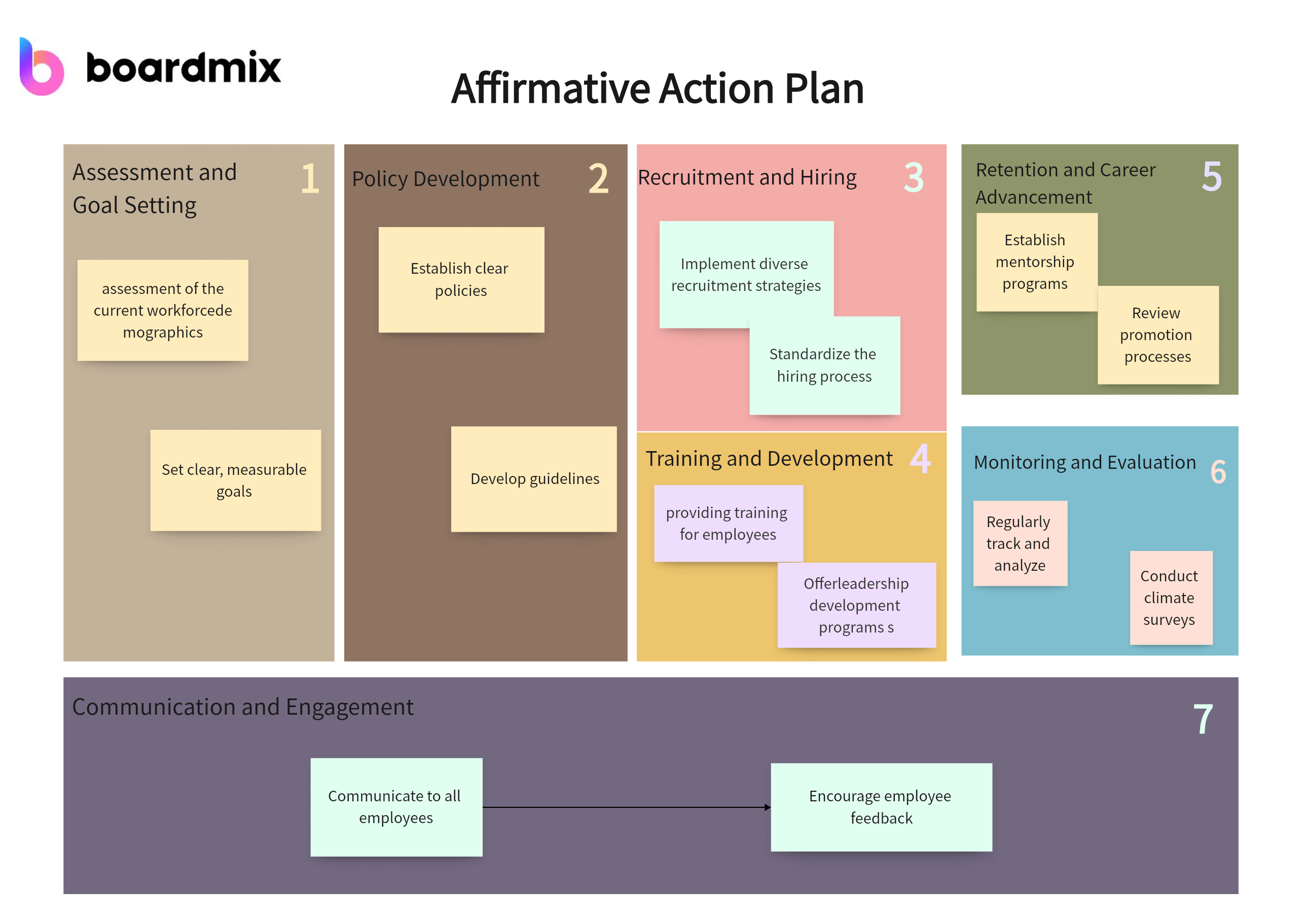
1. Assessment and Goal Setting:
- Conduct a thorough assessment of the current workforce demographics and the diversity of new hires and promotions.
- Set clear, measurable goals for improving diversity and inclusion, aligned with the company's values and objectives.
2. Policy Development:
- Establish clear policies that prohibit discrimination and harassment in all forms.
- Develop guidelines for affirmative action initiatives, including recruitment, promotion, and training programs.
3. Recruitment and Hiring:
- Implement diverse recruitment strategies, such as attending job fairs at diverse institutions and advertising in publications that reach underrepresented groups.
- Standardize the hiring process to minimize unconscious bias, using structured interviews and diverse interview panels.
4. Training and Development:
- Provide mandatory diversity and inclusion training for all employees, focusing on unconscious bias, cultural competency, and inclusive behavior.
- Offer leadership development programs specifically designed for underrepresented groups to prepare them for management and executive roles.
5. Retention and Career Advancement:
- Establish mentorship programs to support the career growth of diverse employees.
- Review promotion processes to ensure they are equitable and provide growth opportunities for all employees.
6. Monitoring and Evaluation:
- Regularly track and analyze diversity metrics to measure progress towards goals.
- Conduct climate surveys to assess the inclusivity of the workplace and address any concerns.
7. Communication and Engagement:
- Communicate the affirmative action plan and its goals to all employees, emphasizing the company's commitment to diversity.
- Encourage employee feedback and involve them in the planning and implementation process.
Project Action Plan
A project action plan outlines the steps and resources needed to complete a specific project. Here's a detailed plan for managing a project effectively:
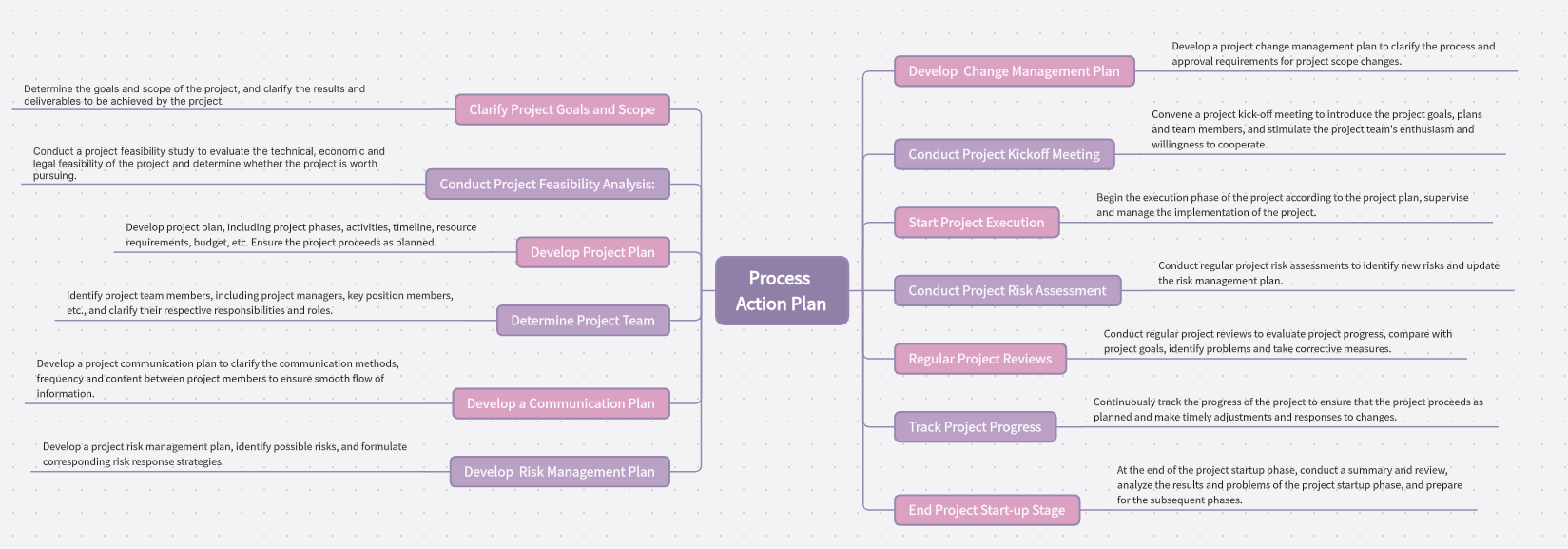
1. Project Definition:
- Clearly define the project scope, objectives, deliverables, and success criteria.
- Identify the project stakeholders and their roles and responsibilities.
2. Resource Allocation:
- Determine the necessary human, financial, and technological resources for the project.
- Assign team members based on their skills and the project's requirements.
3. Schedule Development:
- Create a detailed project timeline with milestones, deadlines, and dependencies.
- Use project management tools to track progress and adjust the schedule as needed.
4. Risk Management:
- Identify potential risks and develop contingency plans to mitigate their impact.
- Regularly review and update the risk register throughout the project.
5. Quality Control:
- Establish quality standards and metrics for the project deliverables.
- Implement quality assurance processes, such as peer reviews and testing, to ensure high-quality outputs.
6. Communication Plan:
- Develop a communication strategy to keep all stakeholders informed about project progress, changes, and issues.
- Schedule regular meetings and updates with the team and stakeholders.
7. Execution and Monitoring:
- Execute the project according to the plan, closely monitoring progress and performance.
- Address any deviations from the plan promptly and adjust the plan as necessary.
8. Evaluation and Closure:
- Conduct a project evaluation upon completion to assess the success of the project and identify lessons learned.
- Document the final results and close the project, ensuring all deliverables are handed over and resources are released.
Action Plan for the Community
An action plan for the community focuses on improving the quality of life for residents and addressing local issues. Here's a detailed plan for community development:

1. Needs Assessment:
- Conduct surveys and community forums to identify the most pressing needs and priorities.
- Analyze available data on local demographics, economic conditions, and social issues.
2. Goal Setting:
- Set specific, measurable goals for community improvement in areas such as education, public safety, health, and infrastructure.
- Engage local leaders and organizations in the goal-setting process to ensure broad support.
3. Resource Mobilization:
- Identify potential funding sources, including grants, donations, and partnerships with local businesses.
- Recruit volunteers and organize community work groups to support the initiatives.
4. Initiative Implementation:
- Develop and implement programs and projects to address the identified needs, such as after-school programs for youth, community gardens, or neighborhood watch groups.
- Coordinate with local government and non-profit organizations to leverage resources and expertise.
5. Community Engagement:
- Organize events and activities to foster community spirit and encourage resident participation.
- Establish communication channels, such as newsletters and social media groups, to keep residents informed and involved.
6. Monitoring and Evaluation:
- Regularly track the progress of initiatives and evaluate their impact on the community.
- Adjust the plan based on feedback from residents and changes in community needs.
Business Action Plan
A business action plan outlines the strategies and tactics to achieve business objectives, such as increasing sales, expanding into new markets, or improving customer satisfaction. Here's a detailed plan for driving business growth:

1. Market Analysis:
- Conduct a thorough analysis of the market, including competitors, trends, and customer needs.
- Identify opportunities for growth and areas where the business can differentiate itself.
2. Objective Setting:
- Set clear, ambitious, yet achievable objectives for the business, such as revenue growth targets or market share increase.
- Break down these objectives into smaller, actionable goals for different departments.
3. Strategy Development:
- Develop a comprehensive business strategy that addresses product development, marketing, sales, and customer service.
- Consider diversification, innovation, and strategic partnerships as part of the growth strategy.
4. Marketing and Sales Plan:
- Create a marketing plan to increase brand awareness and attract new customers, utilizing digital marketing, social media, and traditional advertising.
- Develop a sales strategy that optimizes the sales process and enhances customer relationships.
5. Operational Excellence:
- Streamline operations to improve efficiency and reduce costs, focusing on supply chain management, inventory control, and process optimization.
- Invest in technology and training to enhance productivity and quality.
6. Financial Management:
- Develop a financial plan that includes budgeting, cash flow management, and financial reporting.
- Ensure the business has access to sufficient capital for growth initiatives and contingency planning.
7. Performance Monitoring:
- Establish key performance indicators (KPIs) to measure progress towards business objectives.
- Regularly review financial statements and performance reports to make informed decisions.
Company Action Plan Example
A company action plan is a comprehensive document that outlines the steps a company will take to achieve its strategic goals and objectives. Here's a detailed example of a company action plan:

1. Strategic Planning:
- Conduct a SWOT analysis to identify the company's strengths, weaknesses, opportunities, and threats.
- Develop a strategic plan that aligns with the company's mission, vision, and core values.
2. Goal Alignment:
- Set long-term goals that support the strategic plan and ensure they are aligned with the company's resources and capabilities.
- Break down long-term goals into short-term objectives that can be achieved within a year.
3. Departmental Plans:
- Work with each department to develop specific plans that support the company's strategic objectives.
- Ensure that each department's plan is integrated with the overall company action plan.
4. Talent Management:
- Assess the current workforce to identify skill gaps and development needs.
- Implement talent management programs, such as training and development, performance management, and succession planning.
5. Innovation and Growth:
- Encourage a culture of innovation by providing resources for research and development.
- Explore new markets, products, and services to drive growth and stay competitive.
6. Risk Management and Compliance:
- Identify potential risks to the company's operations and reputation, and develop strategies to mitigate them.
- Ensure compliance with all relevant laws, regulations, and industry standards.
7. Communication and Stakeholder Engagement:
- Communicate the action plan and its objectives to all employees, stakeholders, and partners.
- Establish feedback mechanisms to involve stakeholders in the planning and evaluation process.
8. Performance Measurement and Adjustment:
- Regularly measure performance against the action plan's objectives and adjust the plan as needed.
- Conduct annual reviews to assess the overall effectiveness of the action plan and set new goals for the following year.
Marketing Action Plan
A marketing action plan is a comprehensive strategy designed to achieve specific marketing objectives. Here's a detailed action plan to guide your marketing efforts effectively:
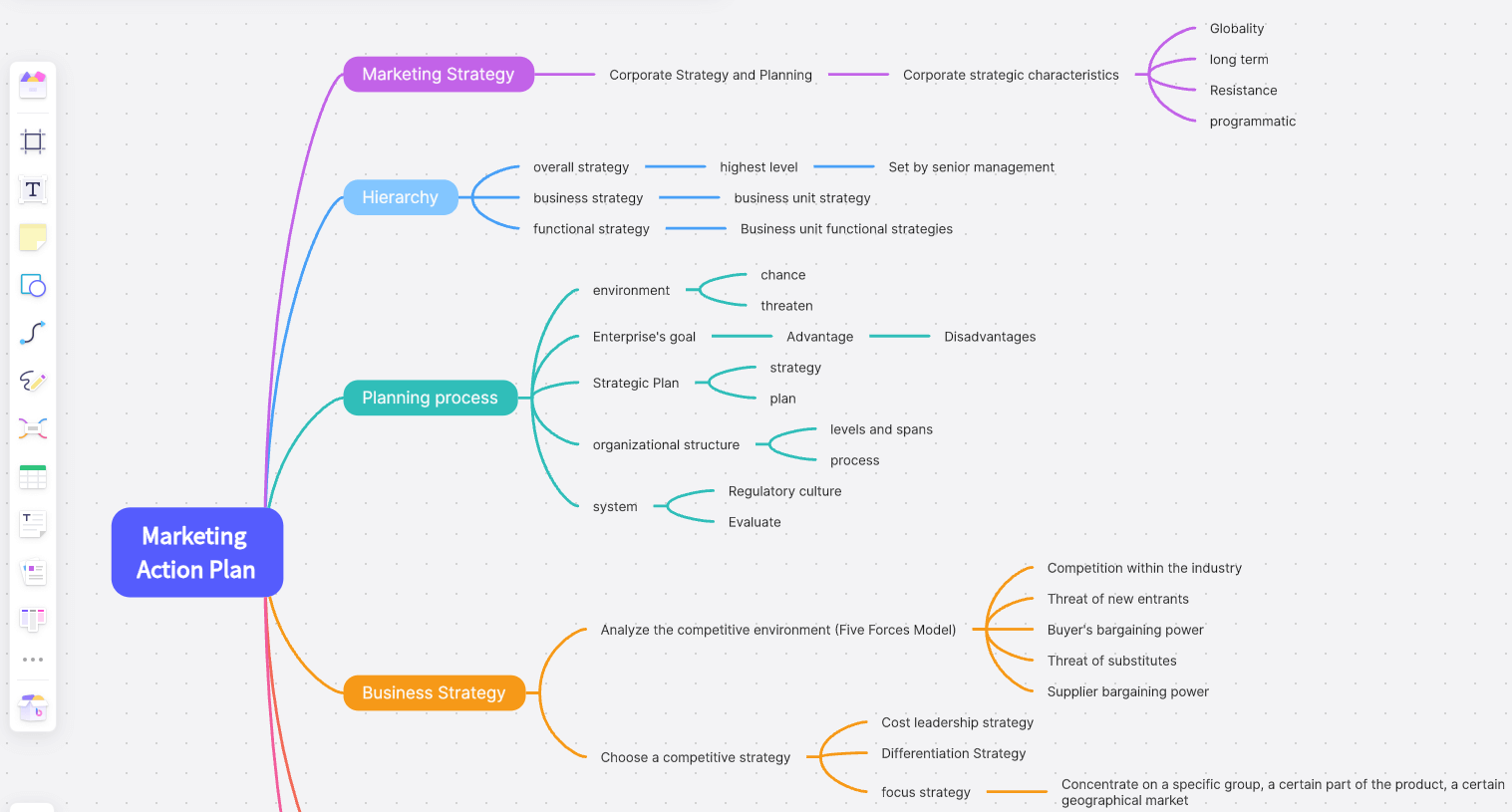
1. Market Research and Analysis:
- Conduct in-depth market research to understand your target audience, their preferences, and pain points.
- Analyze your competitors to identify gaps and opportunities in the market.
2. Objective Setting:
- Define clear, SMART (Specific, Measurable, Achievable, Relevant, Time-bound) marketing objectives.
- For example, "Increase online sales by 20% within the next six months."
3. Marketing Strategy Development:
- Develop a multi-channel marketing strategy that includes digital marketing, social media, email campaigns, content marketing, and traditional marketing methods.
- Tailor your strategy to reach your target audience effectively.
4. Content Creation and Distribution:
- Create a content calendar outlining the topics, formats, and distribution channels for your marketing communications.
- Develop engaging content that resonates with your audience and aligns with your brand message.
5. Campaign Execution:
- Launch marketing campaigns based on your strategy and content calendar.
- Use A/B testing to optimize your campaigns for better results.
6. Budget Allocation:
- Allocate a budget for each marketing channel, ensuring that resources are used efficiently.
- Monitor the ROI (Return on Investment) to make data-driven decisions.
7. Performance Tracking and Analysis:
- Use analytics tools to track the performance of your marketing efforts.
- Regularly review key metrics such as website traffic, conversion rates, and social media engagement.
8. Continuous Improvement:
- Analyze the data to identify areas for improvement.
- Adjust your marketing strategy based on the insights gained from performance analysis.
Action Plan for English Project
An English project action plan is essential for organizing and executing educational initiatives effectively. Here's a detailed action plan for an English project:
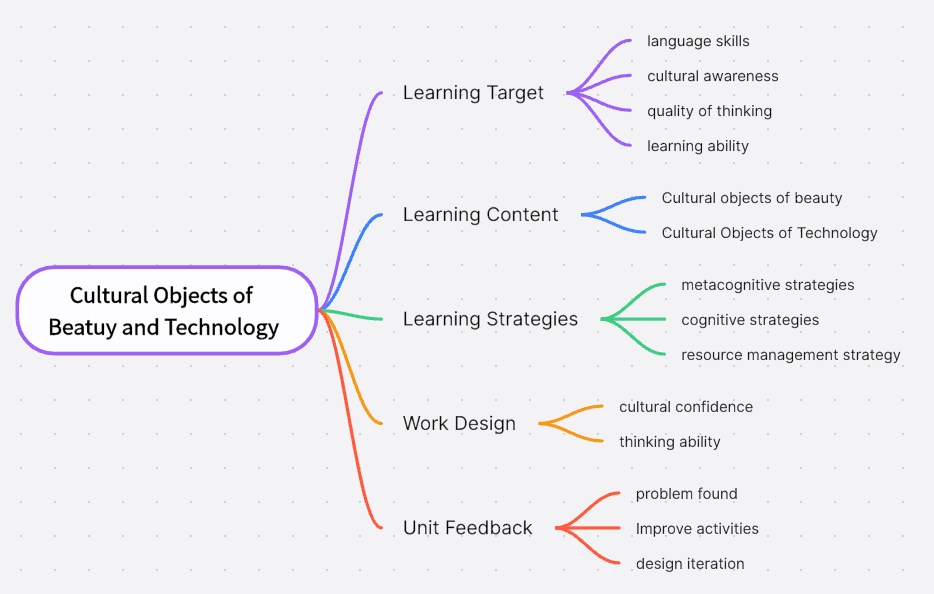
1. Project Goals:
- Define the project's objectives, such as improving students' reading comprehension or enhancing writing skills.
- Ensure that these goals are SMART and aligned with the curriculum.
2. Needs Assessment:
- Evaluate the current English proficiency levels of the students involved in the project.
- Identify specific areas for improvement based on the assessment results.
3. Resource Gathering:
- Collect necessary resources, including textbooks, online materials, and supplementary aids.
- Ensure that these resources are accessible and suitable for the students' learning levels.
4. Lesson Planning:
- Develop a comprehensive lesson plan that covers grammar, vocabulary, reading, writing, listening, and speaking.
- Include a variety of teaching methods, such as lectures, group discussions, and interactive activities.
5. Implementation:
- Execute the lesson plan, incorporating regular assessments to monitor student progress.
- Provide feedback and support to help students overcome challenges.
6. Evaluation:
- Assess the project's effectiveness through tests, quizzes, and student feedback.
- Use the evaluation results to refine the project and improve future initiatives.
7. Parental and Community Involvement:
- Engage parents and the community to support the English project.
- Organize events, workshops, or guest lectures to enhance the learning experience.
CAPA Corrective Action Plan
A CAPA (Corrective and Preventive Action) plan is crucial for addressing and preventing quality issues systematically. Here's a detailed CAPA action plan:
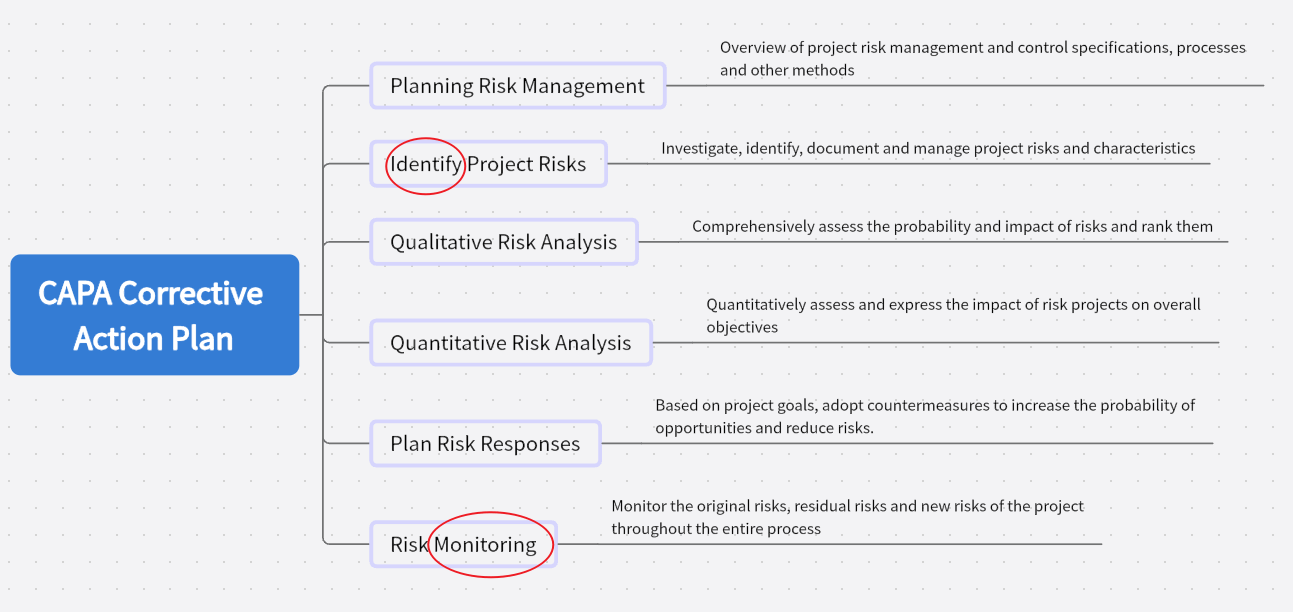
1. Issue Identification:
- Establish a process for identifying and documenting quality issues or deviations.
- Encourage open communication to ensure that all issues are reported promptly.
2. Root Cause Analysis:
- Investigate each issue to determine its root cause.
- Use tools like the 5 Whys or Fishbone Diagram to analyze the problem thoroughly.
3. Corrective Actions:
- Develop and implement corrective actions to address the root cause and resolve the issue.
- Ensure that these actions are effective, timely, and well-documented.
4. Preventive Actions:
- Identify and implement preventive actions to avoid the recurrence of the issue.
- These actions should be based on the root cause analysis and address potential risks proactively.
5. Documentation and Training:
- Document all aspects of the CAPA process, including the issue description, investigation findings, actions taken, and outcomes.
- Train employees on the CAPA process and the importance of quality control.
6. Monitoring and Follow-up:
- Monitor the effectiveness of the corrective and preventive actions.
- Schedule regular follow-up reviews to assess the long-term impact of the actions and make further adjustments if necessary.
Development Action Plan
A development action plan is designed to guide the growth and improvement of an organization or individual. Here's a detailed development action plan:

1. Objective Setting:
- Define clear, SMART objectives for the development plan, focusing on areas such as skill enhancement, career advancement, or organizational growth.
- For example, "Improve team leadership skills to increase employee satisfaction and productivity."
2. Skill Assessment:
- Conduct a skills assessment to identify strengths and areas for improvement.
- Use feedback from peers, supervisors, and self-assessment to gain a comprehensive understanding of your capabilities.
3. Training and Development:
- Develop a training plan that includes workshops, seminars, online courses, or mentorship programs.
- Tailor the training to address the identified skill gaps and align with your development objectives.
4. Implementation:
- Execute the training plan, ensuring that all participants have access to the necessary resources and support.
- Monitor progress and adjust the plan as needed based on feedback and results.
5. Performance Evaluation:
- Evaluate the effectiveness of the development plan through performance reviews and feedback.
- Use the evaluation results to refine the plan and set new development goals.
6. Continuous Learning:
- Encourage a culture of continuous learning and professional development.
- Stay updated with industry trends and best practices to maintain a competitive edge.
Action Plan for Research
An action plan for research is essential for managing and executing research projects effectively. Here's a detailed action plan for conducting research:
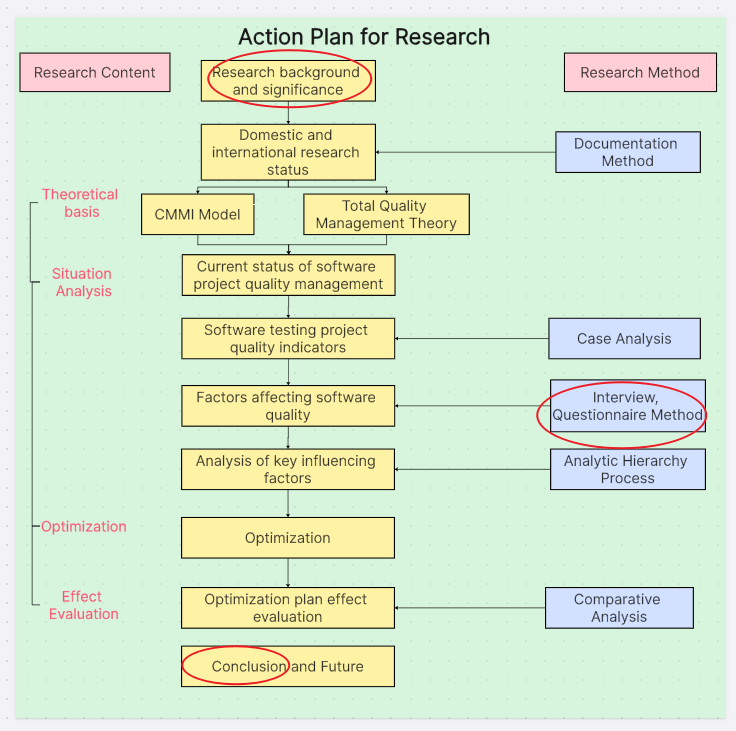
1. Research Objectives:
- Define the research objectives, ensuring they are clear, focused, and aligned with the broader research field.
- For example, "Investigate the impact of social media on mental health among teenagers."
2. Literature Review:
- Conduct a thorough literature review to understand the current state of research in your area of interest.
- Identify gaps in the existing research that your study can address.
3. Methodology Development:
- Develop a research methodology that is appropriate for your objectives and questions.
- Choose suitable research methods, such as surveys, interviews, or experiments, and design the data collection process.
4. Data Collection and Analysis:
- Collect data according to your research plan, ensuring compliance with ethical guidelines.
- Analyze the data using appropriate statistical methods or qualitative analysis techniques.
5. Results Interpretation:
- Interpret the results, drawing conclusions that are supported by your data.
- Discuss the implications of your findings and their contribution to the field.
6. Dissemination:
- Prepare research papers, articles, or presentations to share your findings with the academic community.
- Submit your work to relevant journals, conferences, or other platforms for peer review and feedback.
7. Review and Reflection:
- Review the research process to identify areas for improvement in future projects.
- Reflect on the lessons learned and apply them to enhance your research skills and methodologies.
Key Takeaways: Free Action Plan Templates & Tool
As an online whiteboard tool, Boardmix is designed with user convenience and efficiency in mind with rich free templates including the action plan template. They provide a clear structure for your action plan, guiding you step by step as you strategize and implement your goals.
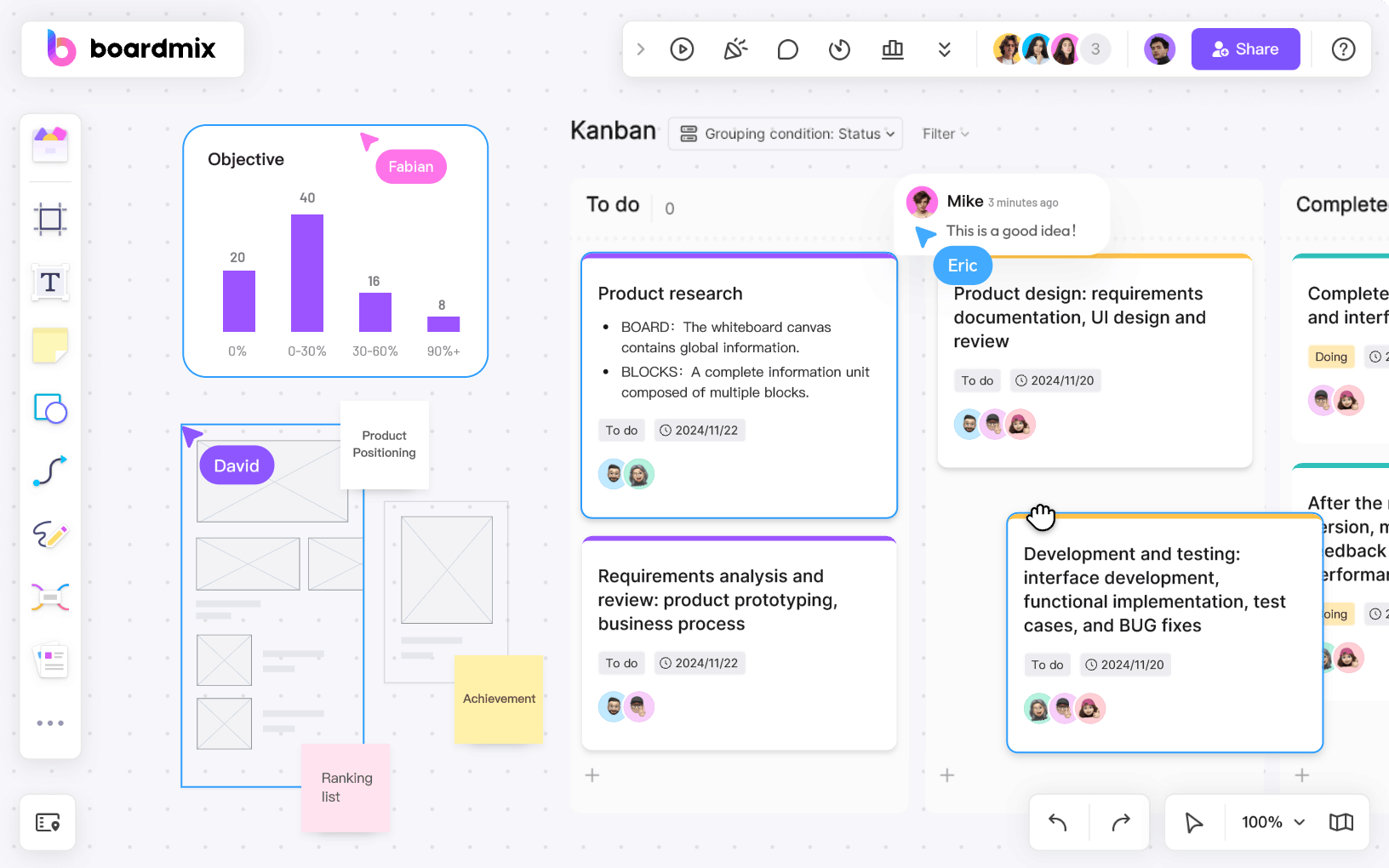
With the pre-structured action templates, Boardmix takes the guesswork out of creating an action plan. The templates provide a standard layout that ensures you capture all the crucial aspects of an effective action plan, including objectives, tasks, responsibilities, timelines, and resources.
Using Boardmix's free action plan templates is simple:
1. Sign up for free and choose a template that fits your needs.
2. Define your project goal clearly in the template.
3. Identify and list the objectives necessary to achieve this goal.
4. Determine the tasks required to meet each objective and assign them to team members.
5. Set a timeline for each task.
6. Identify the resources required for each task.
7. Continually monitor the progress of your plan and adjust as necessary.
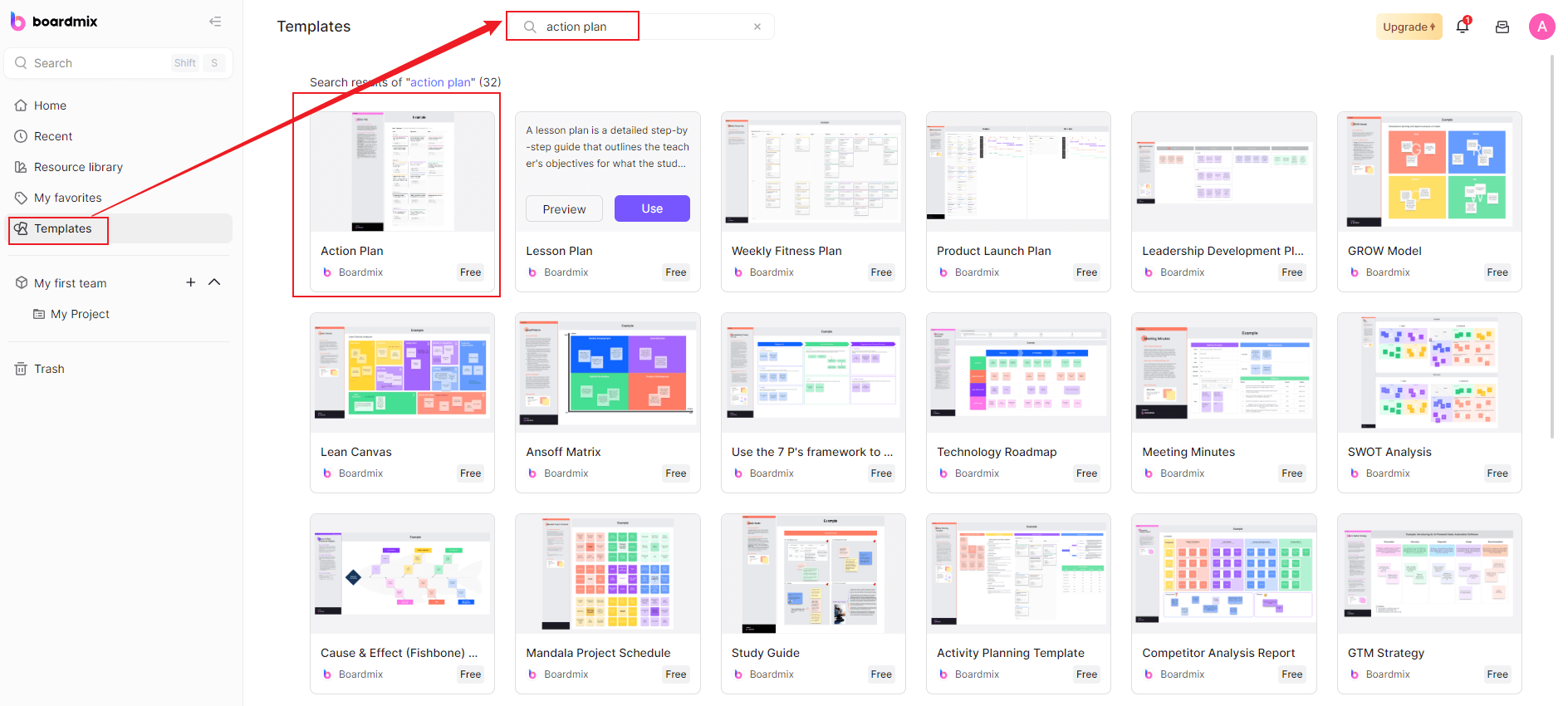
When it comes to developing an effective action plan, Boardmix is a one-stop solution offering free templates and intuitive tools designed to streamline the process and foster successful project execution. Start leveraging Boardmix's features today and empower your team with a structured and efficient way of turning plans into actions.









